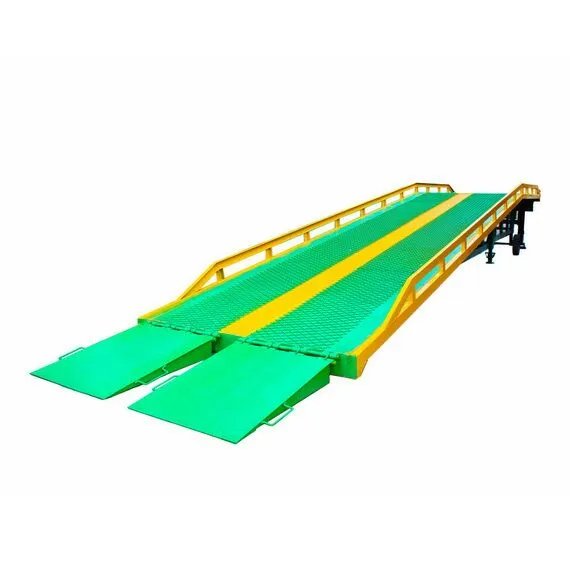Loading docks are critical hubs in warehouses and distribution centers, where goods are transferred between trucks and storage facilities. The smooth and safe operation of these docks directly impacts overall productivity, employee well-being, and operational efficiency. Among the essential equipment contributing to dock safety is the mini dock leveler—a compact yet powerful tool designed to bridge the gap between dock floors and vehicle beds.
Mini dock levelers play a significant role in enhancing safety in loading dock environments, especially where space constraints or lighter-duty operations make full-sized dock levelers impractical. This article explores how mini dock leveler improve safety measures in loading docks while supporting efficient workflow.
Understanding the Mini Dock Leveler
A mini dock leveler is a smaller version of traditional dock levelers, designed for facilities with limited space or less demanding loading requirements. Despite their compact size, mini dock levelers provide a reliable, adjustable platform that compensates for height differences between the dock and truck beds. This adjustment is crucial to preventing accidents caused by uneven surfaces or gaps during loading and unloading.
These units typically use mechanical or hydraulic mechanisms to raise or lower the platform, offering smooth transitions that protect workers and cargo alike. Their smaller footprint makes them ideal for warehouses or loading areas where large dock levelers are not feasible, yet safety and operational continuity remain a priority.
How Mini Dock Levelers Improve Safety
1. Eliminating Height Differences and Gaps
One of the most common hazards in loading docks is the uneven surface between the dock floor and truck bed. This difference can lead to slips, trips, and falls, causing serious injuries to personnel or damage to goods and equipment.
Mini dock levelers effectively bridge this gap by creating a level surface that adapts to the truck’s height. By eliminating abrupt edges and height variations, these levelers reduce the risk of accidents during cargo transfers. Workers can move forklifts, pallet jacks, and hand trucks safely across the dock leveler without fear of tipping or losing control.
2. Enhancing Stability for Loading Equipment
Forklifts and pallet jacks are vital to dock operations, but they require stable and even surfaces to operate safely. Mini dock levelers provide a solid platform that supports the weight and movement of such equipment, preventing potential mishaps caused by unstable surfaces.
By maintaining stability, mini dock levelers allow operators to maneuver efficiently, lowering the chances of forklift tip-overs or collisions. This stability is particularly important in busy loading areas, where multiple workers and vehicles operate in close proximity.
3. Facilitating Safe Handling of Goods
Handling heavy or bulky goods demands a secure environment to minimize accidents. Mini dock levelers contribute by ensuring smooth, controlled access between dock and vehicle, reducing jarring movements that can lead to dropped or damaged goods.
By providing a reliable transition surface, they help workers maintain balance and control over loads. This control not only safeguards the workforce but also prevents costly damage to merchandise, which can occur when goods shift unexpectedly during loading or unloading.
4. Compact Design Reduces Clutter and Obstructions
Space constraints in loading docks often contribute to unsafe working conditions. Crowded areas with clutter or uneven surfaces increase the risk of accidents.
The compact design of mini dock levelers is advantageous in tight spaces, as they require less floor space than standard dock levelers. This smaller footprint means docks can remain more organized and free of obstacles, improving overall safety. Clear pathways reduce trip hazards and provide sufficient room for operators to maneuver equipment safely.
Operational Benefits That Support Safety
Beyond direct safety improvements, mini dock levelers also contribute indirectly by enhancing operational efficiency and reducing fatigue:
- Quicker Docking Procedures: Mini dock levelers simplify and speed up the loading and unloading processes. Faster transitions mean less time spent on precarious movements, reducing worker exposure to hazards.
- Reduced Physical Strain: By providing a smooth, level surface, mini dock levelers reduce the physical effort required by dock workers to push or pull heavy loads. This reduction in strain lowers the risk of repetitive motion injuries or muscle fatigue.
- Improved Ergonomics: Properly adjusted dock levelers allow workers to maintain ergonomic postures while loading or unloading, further decreasing injury risks.
Conclusion
Mini dock levelers provide an essential safety enhancement in loading dock operations. By bridging height gaps, stabilizing loading equipment, and facilitating secure handling of goods, they mitigate many common hazards found in dock environments. Their compact design, durable construction, and safety features further contribute to a safer, more efficient workplace.
As warehouses and distribution centers face increasing pressure to maintain high safety standards while optimizing productivity, mini dock levelers offer a practical, cost-effective solution. Integrating these devices into dock operations supports employee well-being and operational excellence, making them an indispensable asset in modern logistics.
For businesses aiming to enhance dock safety and streamline material handling, investing in a high-quality mini dock leveler is a step towards safer, smarter loading dock management.









